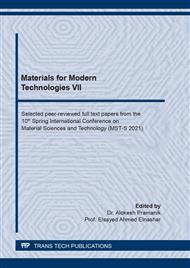[1]
Lubinski, A., 1961. Maximum permissible dog-legs in rotary bore holes. Trans., AIME. 222.
Google Scholar
[2]
Bradley, W.B. Fontenot, J.E., 1975. The prediction and control of casing wear. Journal of Petroleum Technology. 2, 233-245.
Google Scholar
[3]
Williamson, S.J., 1981. Casing wear: the effect of contact pressure. Journal of Petroleum Technology, 33(12), 2382-2388.
DOI: 10.2118/10236-pa
Google Scholar
[4]
Best, B., 1986. Casing wear caused by tooljoint hardfacing. SPE Drilling Engineering. 1(01), 62-70.
DOI: 10.2118/11992-pa
Google Scholar
[5]
White, J.P., Dawson, R., 1987. Casing wear: laboratory measurements and field predictions. SPE Drilling Engineering. 2(01), 56-62.
DOI: 10.2118/14325-pa
Google Scholar
[6]
Yu, H., Zhang, L., Fan, J., 2006. Summary of casing wear mechanism and test research in deep & ultra-deep well. Oil Field Equipment. 35(4), 4-7.
Google Scholar
[7]
Dong, X., Yang, Z., He, W., 2008. Study and development of casing wear. Oil Field Equipment. 37(4), 32-36.
Google Scholar
[8]
Li, B., Fan, S., Zhang, J., 2011. The research on off-center wears of sucker rod string and bar tube in horizontal well. Intelligent Information Technology Application Association. 450-454.
DOI: 10.1115/1.859896.paper89
Google Scholar
[9]
Cao, Y., Wang, X., Wang, X., Dou, Y., 2013. Research on the effects of drilling fluid density on high grade steel casing abrasion. China Petroleum Machinery. 41(8), 5-8.
Google Scholar
[10]
Liang, E., Li, Z., Wang, J., Zhou, L., 2015. Experimental study on casing wear mechanism in oil and gas wells. Petroleum Drilling Techniques. 43(1), 69-74.
Google Scholar
[11]
Yu, H., Lian, Z., Lin, T., Liu, Y., Xu, X., 2016. Experimental and numerical study on casing wear in highly deviated drilling for oil and gas. Advances in Mechanical Engineering. 8(7), 1-15.
DOI: 10.1177/1687814016656535
Google Scholar
[12]
Dang, X.W., 2017. The research on fatigue wear mechanism based on 35CrMo/GCr15 friction pair. Lanzhou: Lanzhou University of Technology.
Google Scholar
[13]
Matsumoto, K., Sagara, M., Miyajima, M., Kitamura, K., Amaya, H., 2017. Study of oil country tubular goods casing and liner wear mechanism on corrosion-resistant alloys. SPE Drilling & Completion. 187946.
DOI: 10.2118/187946-pa
Google Scholar
[14]
Park, C.Y., Rhee, H., Ryu, K., 2018. Wear depth prediction for steam generator tubes using an estimated in situ wear coefficient, Nuclear Technology. 201(01), 23-40.
DOI: 10.1080/00295450.2017.1392396
Google Scholar
[15]
Yu, H., Taleghani, A.D., Lian, Z., 2018. Modelling casing wear at doglegs by incorporating alternate accumulative wear. Journal of Petroleum Science and Engineering. 168, 273-282.
DOI: 10.1016/j.petrol.2018.05.009
Google Scholar
[16]
Guo, J., Fan, S., Liu, T., Lu, M., Yao, Y., Liang, Y., Zhao, C., et al., 2018. Exploration and practice of integrated control technology for tubing and sucker rod lopsided wearing in directional well. IOP Conference. 208.
DOI: 10.1088/1755-1315/208/1/012021
Google Scholar
[17]
Xu, X., Wang, T., Yu, H., Dong, H., Li, X., 2019. Friction and wear properties of CT80 tubing under low friction velocity. Lubrication Engineering. 44(2), 66-71.
Google Scholar
[18]
Mao, L., Cai, M., Tian, J., Luo, J., 2020. Effect of drilling fluid type on wear behavior of casing. Journal of Materials Science and Engineering. 38(3), 482-487.
Google Scholar
[19]
Mao, L., Cai, M., Wang, G., 2018. Effect of rotation speed on the abrasive-erosive-corrosive wear of steel pipes against steel casings used in drilling for petroleum. Wear. 410-411, 1-10.
DOI: 10.1016/j.wear.2018.06.002
Google Scholar
[20]
Wen S.T., 2018. Principles of tribology fifth edition. Beijing: Tsinghua university press.
Google Scholar
[21]
Liu J., Guo X., Wang G., Liu, Q., Fang, D., Huang, L., Mao, L., 2020. Bi-nonlinear vibration model of tubing string in oil & gas well and its experimental verification. Applied Mathematical Modelling, 81, 50-69.
DOI: 10.1016/j.apm.2019.09.057
Google Scholar


